springboot与缓存(redis,或者caffeine,guava)
1.理论介绍
Java Caching定义了5个核心接口,分别是CachingProvider, CacheManager, Cache, Entry 和 Expiry。
CachingProvider定义了创建、配置、获取、管理和控制多个CacheManager。一个应用可以在运行期访问多个CachingProvider。
CacheManager定义了创建、配置、获取、管理和控制多个唯一命名的Cache,这些Cache存在于CacheManager的上下文中。一个CacheManager仅被一个CachingProvider所拥有。
Cache是一个类似Map的数据结构并临时存储以Key为索引的值。一个Cache仅被一个CacheManager所拥有。
Entry是一个存储在Cache中的key-value对。
Expiry 每一个存储在Cache中的条目有一个定义的有效期。一旦超过这个时间,条目为过期的状态。一旦过期,条目将不可访问、更新和删除。缓存有效期可以通过ExpiryPolicy设置。
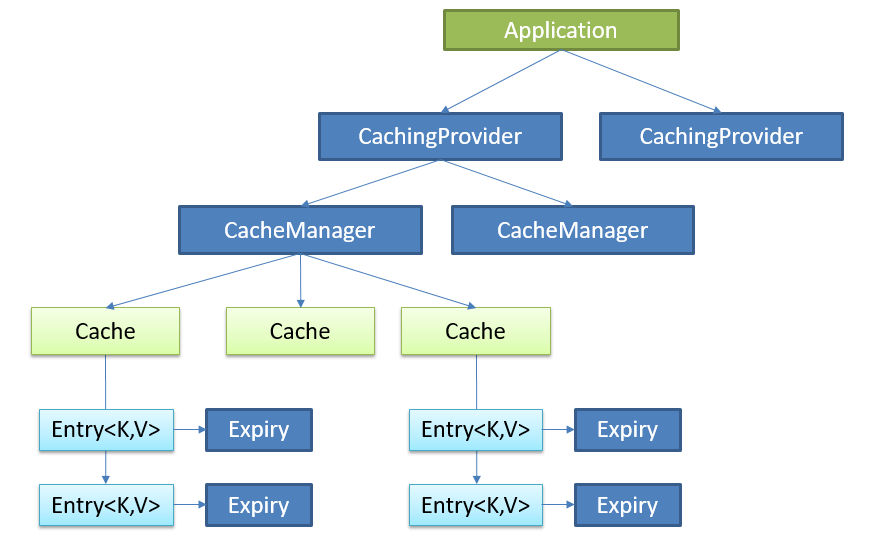
Spring缓存抽象 Spring从3.1开始定义了org.springframework.cache.Cache
和org.springframework.cache.CacheManager接口来统一不同的缓存技术;
并支持使用JCache(JSR-107)注解简化我们开发; Cache接口为缓存的组件规范定义,包含缓存的各种操作集合;
Cache接口下Spring提供了各种xxxCache的实现;如RedisCache,EhCacheCache , ConcurrentMapCache等; 每次调用需要缓存功能的方法时,Spring会检查检查指定参数的指定的目标方法是否已经被调用过;如果有就直接从缓存中获取方法调用后的结果,如果没有就调用方法并缓存结果后返回给用户。下次调用直接从缓存中获取。
使用Spring缓存抽象时我们需要关注以下两点;
1、确定方法需要被缓存以及他们的缓存策略
2、从缓存中读取之前缓存存储的数据
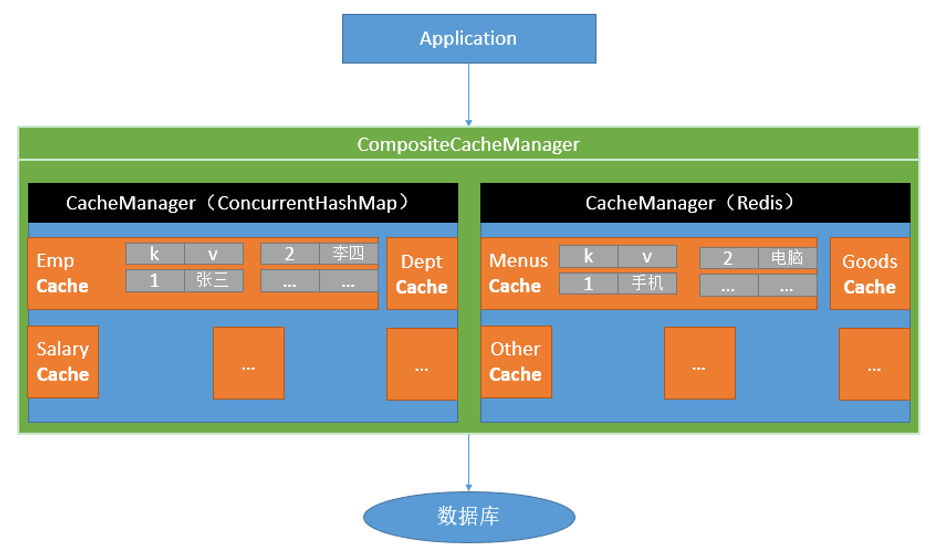
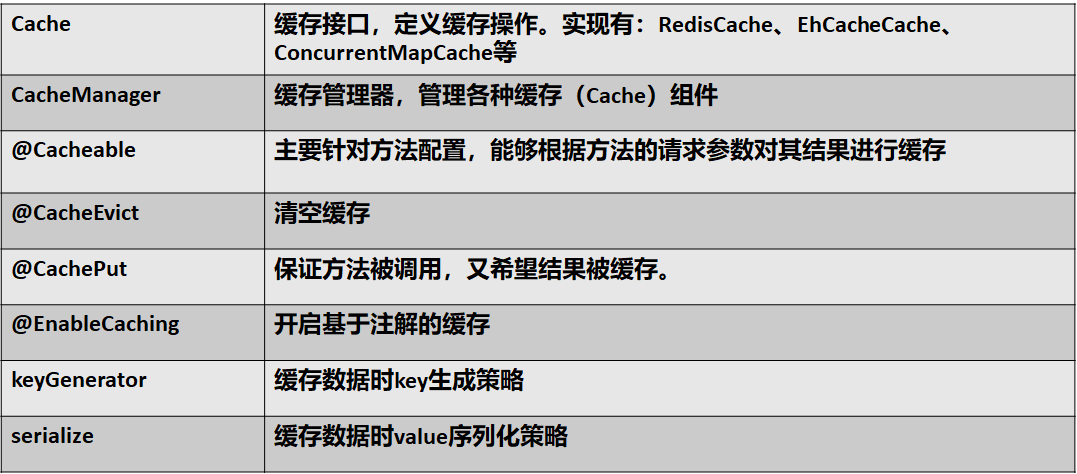
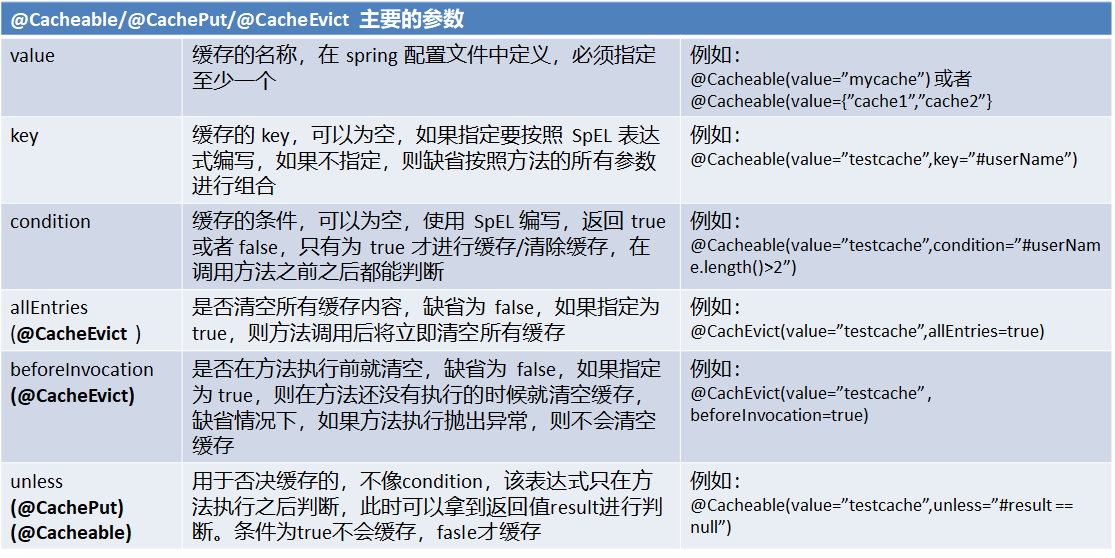

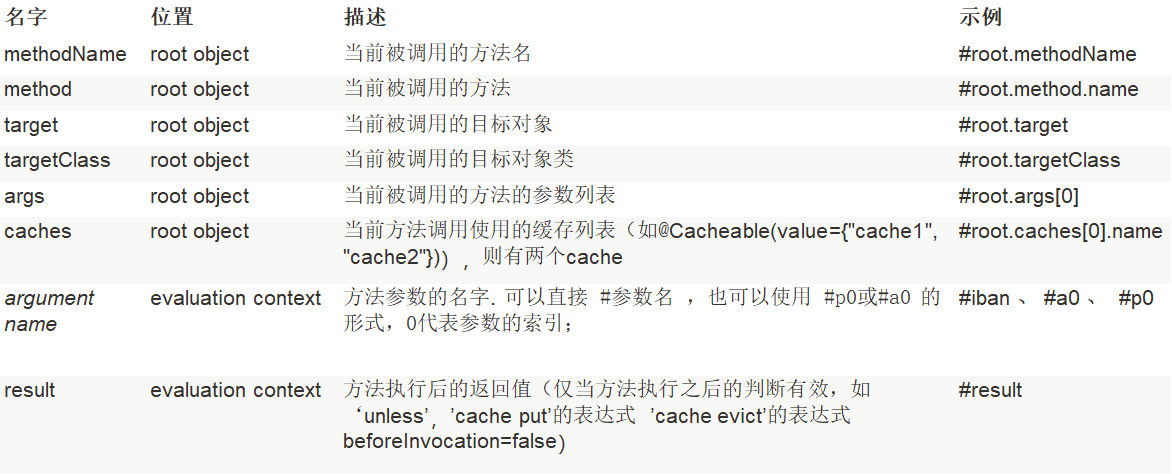
2.代码结构及pom文件

<?xml version="1.0" encoding="UTF-8"?>
<project xmlns="http://maven.apache.org/POM/4.0.0" xmlns:xsi="http://www.w3.org/2001/XMLSchema-instance"
xsi:schemaLocation="http://maven.apache.org/POM/4.0.0 http://maven.apache.org/xsd/maven-4.0.0.xsd">
<modelVersion>4.0.0</modelVersion> <groupId>com.zy</groupId>
<artifactId>spring-boot-cache</artifactId>
<version>0.0.1-SNAPSHOT</version>
<packaging>jar</packaging> <name>spring-boot-cache</name>
<description>Demo project for Spring Boot</description> <parent>
<groupId>org.springframework.boot</groupId>
<artifactId>spring-boot-starter-parent</artifactId>
<version>1.5.14.RELEASE</version>
<relativePath/> <!-- lookup parent from repository -->
</parent> <properties>
<project.build.sourceEncoding>UTF-8</project.build.sourceEncoding>
<project.reporting.outputEncoding>UTF-8</project.reporting.outputEncoding>
<java.version>1.8</java.version>
<lombok.version>1.16.10</lombok.version>
</properties> <dependencies>
<dependency>
<groupId>org.springframework.boot</groupId>
<artifactId>spring-boot-starter-cache</artifactId>
</dependency>
<dependency>
<groupId>org.springframework.boot</groupId>
<artifactId>spring-boot-starter-jdbc</artifactId>
</dependency>
<dependency>
<groupId>org.springframework.boot</groupId>
<artifactId>spring-boot-starter-web</artifactId>
</dependency>
<dependency>
<groupId>org.mybatis.spring.boot</groupId>
<artifactId>mybatis-spring-boot-starter</artifactId>
<version>1.3.2</version>
</dependency>
<!-- 引入redis的starter,这里面有jedis客户端 -->
<dependency>
<groupId>org.springframework.boot</groupId>
<artifactId>spring-boot-starter-data-redis</artifactId>
</dependency> <dependency>
<groupId>mysql</groupId>
<artifactId>mysql-connector-java</artifactId>
<scope>runtime</scope>
</dependency>
<dependency>
<groupId>org.springframework.boot</groupId>
<artifactId>spring-boot-starter-test</artifactId>
<!--<scope>test</scope>-->
</dependency> <!-- 引入lombok的依赖 -->
<dependency>
<groupId>org.projectlombok</groupId>
<artifactId>lombok</artifactId>
<version>${lombok.version}</version>
</dependency> <!-- 引入caffeine缓存Jar包 -->
<dependency>
<groupId>com.github.ben-manes.caffeine</groupId>
<artifactId>caffeine</artifactId>
<version>2.6.0</version>
</dependency>
</dependencies> <build>
<plugins>
<plugin>
<groupId>org.springframework.boot</groupId>
<artifactId>spring-boot-maven-plugin</artifactId>
</plugin>
</plugins>
</build> </project>
3.启动类
package com.zy; import org.mybatis.spring.annotation.MapperScan;
import org.springframework.boot.SpringApplication;
import org.springframework.boot.autoconfigure.SpringBootApplication;
import org.springframework.cache.annotation.EnableCaching;
/**
* 一、搭建基本环境
* 1、导入数据库文件 创建出department和employee表
* 2、创建javaBean封装数据
* 3、整合MyBatis操作数据库
* 1.配置数据源信息
* 2.使用注解版的MyBatis;
* 1)、@MapperScan指定需要扫描的mapper接口所在的包
* 二、快速体验缓存
* 步骤:
* 1、开启基于注解的缓存 @EnableCaching
* 2、标注缓存注解即可
* @Cacheable
* @CacheEvict
* @CachePut
* 默认使用的是ConcurrentMapCacheManager==ConcurrentMapCache;将数据保存在 ConcurrentMap<Object, Object>中
* 开发中使用缓存中间件;redis、memcached、ehcache;
* 三、整合redis作为缓存
* Redis 是一个开源(BSD许可)的,内存中的数据结构存储系统,它可以用作数据库、缓存和消息中间件。
* 1、安装redis:使用docker;
* 2、引入redis的starter
* 3、配置redis
* 4、测试缓存
* 原理:CacheManager===Cache 缓存组件来实际给缓存中存取数据
* 1)、引入redis的starter,容器中保存的是 RedisCacheManager;
* 2)、RedisCacheManager 帮我们创建 RedisCache 来作为缓存组件;RedisCache通过操作redis缓存数据的
* 3)、默认保存数据 k-v 都是Object;利用序列化保存;如何保存为json
* 1、引入了redis的starter,cacheManager变为 RedisCacheManager;
* 2、默认创建的 RedisCacheManager 操作redis的时候使用的是 RedisTemplate<Object, Object>
* 3、RedisTemplate<Object, Object> 是 默认使用jdk的序列化机制
* 4)、自定义CacheManager;
*
*/
@SpringBootApplication
// 扫描mapper,支持mybatis
@MapperScan("com.zy.mapper")
// 开启缓存注解,此外,还要在service层加上缓存注解@Cacheable才能生效
@EnableCaching
public class SpringBootCacheApplication { public static void main(String[] args) {
SpringApplication.run(SpringBootCacheApplication.class, args);
}
}
4.model层对象
package com.zy.model; import com.fasterxml.jackson.annotation.JsonIgnoreProperties;
import lombok.*; import java.io.Serializable; @Data
@NoArgsConstructor
@AllArgsConstructor
@Builder
@JsonIgnoreProperties(ignoreUnknown = true)
public class Employee implements Serializable { private Integer id; private String lastName; private String email; //1 male, 0 female
private Integer gender; private Integer dId; } package com.zy.model;
/**
*
* 部门的实体类
*/ import com.fasterxml.jackson.annotation.JsonIgnoreProperties;
import lombok.AllArgsConstructor;
import lombok.Builder;
import lombok.Data;
import lombok.NoArgsConstructor; import java.io.Serializable; @Data
@NoArgsConstructor
@AllArgsConstructor
@Builder
@JsonIgnoreProperties(ignoreUnknown = true)
public class Department implements Serializable { private Integer id; private String departmentName; }
5.mapper层
package com.zy.mapper; import com.zy.model.Employee;
import org.apache.ibatis.annotations.Delete;
import org.apache.ibatis.annotations.Insert;
import org.apache.ibatis.annotations.Select;
import org.apache.ibatis.annotations.Update; import java.util.List; /**
*
* employee是xml配置文件版的mapper
*/
// 此处@Mapper也可以不写,但是要在springboot启动类出加上注解@MapperScan
// @Mapper
public interface EmployeeMapper { @Select("SELECT * FROM employee WHERE id = #{id}")
public Employee getEmpById(Integer id); @Update("UPDATE employee SET lastName=#{lastName},email=#{email},gender=#{gender},dId=#{dId} WHERE id=#{id}")
public void updateEmp(Employee employee); @Delete("DELETE FROM employee WHERE id=#{id}")
public void deleteEmpById(Integer id); @Insert("INSERT INTO employee(lastName,email,gender,dId) VALUES(#{lastName},#{email},#{gender},#{dId})")
public void insertEmployee(Employee employee); @Select("SELECT * FROM employee WHERE lastName = #{lastName}")
Employee getEmpByLastName(String lastName); } package com.zy.mapper;
/**
*
* department是注解版的mybatis
*/ import com.zy.model.Department;
import org.apache.ibatis.annotations.*; // 此处@Mapper也可以不写,但是要在springboot启动类出加上注解@MapperScan
// @Mapper
public interface DepartmentMapper { @Options(useGeneratedKeys = true, keyProperty = "id")
@Insert("insert into department(departmentName) values(#{departmentName})")
public int addDept(Department department); @Delete("delete from department where id=#{id}")
public void deleteDeptById(Integer id); @Update("update department set departmentName=#{departmentName} where id=#{id}")
public void updateDeptById(Integer id); @Select("select * from department where id=#{id}")
public Department getDeptById(Integer id);
}
6.service层实现类
package com.zy.service; import com.zy.mapper.EmployeeMapper;
import com.zy.model.Employee;
import org.springframework.beans.factory.annotation.Autowired;
import org.springframework.cache.annotation.*;
import org.springframework.stereotype.Service; // 抽取公共配置-->到类上
@CacheConfig(cacheNames="emp")
@Service("employeeService")
public class EmployeeServiceImpl { @Autowired
private EmployeeMapper employeeMapper; /**
* 将方法的运行结果进行缓存;以后再要相同的数据,直接从缓存中获取,不用调用方法;
* CacheManager管理多个Cache组件的,对缓存的真正CRUD操作在Cache组件中,每一个缓存组件有自己唯一一个名字;
* *
* 原理:
* 1、自动配置类;CacheAutoConfiguration
* 2、缓存的配置类
* org.springframework.boot.autoconfigure.cache.GenericCacheConfiguration
* org.springframework.boot.autoconfigure.cache.JCacheCacheConfiguration
* org.springframework.boot.autoconfigure.cache.EhCacheCacheConfiguration
* org.springframework.boot.autoconfigure.cache.HazelcastCacheConfiguration
* org.springframework.boot.autoconfigure.cache.InfinispanCacheConfiguration
* org.springframework.boot.autoconfigure.cache.CouchbaseCacheConfiguration
* org.springframework.boot.autoconfigure.cache.RedisCacheConfiguration
* org.springframework.boot.autoconfigure.cache.CaffeineCacheConfiguration
* org.springframework.boot.autoconfigure.cache.GuavaCacheConfiguration
* org.springframework.boot.autoconfigure.cache.SimpleCacheConfiguration【默认】
* org.springframework.boot.autoconfigure.cache.NoOpCacheConfiguration
* 3、哪个配置类默认生效:SimpleCacheConfiguration;
*
* 4、给容器中注册了一个CacheManager:ConcurrentMapCacheManager
* 5、可以获取和创建ConcurrentMapCache类型的缓存组件;他的作用将数据保存在ConcurrentMap中;
*
* 运行流程:
* @Cacheable:
* 1、方法运行之前,先去查询Cache(缓存组件),按照cacheNames指定的名字获取;
* (CacheManager先获取相应的缓存),第一次获取缓存如果没有Cache组件会自动创建。
* 2、去Cache中查找缓存的内容,使用一个key,默认就是方法的参数;
* key是按照某种策略生成的;默认是使用keyGenerator生成的,默认使用SimpleKeyGenerator生成key;
* SimpleKeyGenerator生成key的默认策略;
* 如果没有参数;key=new SimpleKey();
* 如果有一个参数:key=参数的值
* 如果有多个参数:key=new SimpleKey(params);
* 3、没有查到缓存就调用目标方法;
* 4、将目标方法返回的结果,放进缓存中
*
* @Cacheable标注的方法执行之前先来检查缓存中有没有这个数据,默认按照参数的值作为key去查询缓存,
* 如果没有就运行方法并将结果放入缓存;以后再来调用就可以直接使用缓存中的数据;
*
* 核心:
* 1)、使用CacheManager【ConcurrentMapCacheManager】按照名字得到Cache【ConcurrentMapCache】组件
* 2)、key使用keyGenerator生成的,默认是SimpleKeyGenerator
*
*
* 几个属性:
* cacheNames或者value:指定缓存组件的名字;将方法的返回结果放在哪个缓存中,是数组的方式,可以指定多个缓存;
*
* key:缓存数据使用的key;可以用它来指定。默认是使用方法参数的值 1-方法的返回值
* 编写SpEL; #id;参数id的值 #a0 #p0 #root.args[0]
* getEmp[2]
*
* keyGenerator:key的生成器;可以自己指定key的生成器的组件id
* key和keyGenerator:二选一使用;
*
*
* cacheManager:指定缓存管理器;或者cacheResolver指定获取解析器;二选一使用;
*
* condition:指定符合条件的情况下才缓存;
* ,condition = "#id>0"
* condition = "#a0>1":第一个参数的值》1的时候才进行缓存
*
* unless:否定缓存;当unless指定的条件为true,方法的返回值就不会被缓存;可以获取到结果进行判断
* unless = "#result == null"
* unless = "#a0==2":如果第一个参数的值是2,结果不缓存;
* sync:是否使用异步模式
* @param id
* @return
*
*/
// 此处与启动类的@EnableCaching注解连用才能生效
@Cacheable(value = "{emp}")
public Employee getEmpById(Integer id){
Employee employee = employeeMapper.getEmpById(id);
return employee;
} /**
* @CachePut:既调用方法,又更新缓存数据;同步更新缓存
* 修改了数据库的某个数据,同时更新缓存;
* 运行时机:
* 1、先调用目标方法
* 2、将目标方法的结果缓存起来
*
* 测试步骤:
* 1、查询1号员工;查到的结果会放在缓存中;
* key:1 value:lastName:张三
* 2、以后查询还是之前的结果
* 3、更新1号员工;【lastName:zhangsan;gender:0】
* 将方法的返回值也放进缓存了;
* key:传入的employee对象 值:返回的employee对象;
* 4、查询1号员工?
* 应该是更新后的员工;
* key = "#employee.id":使用传入的参数的员工id;
* key = "#result.id":使用返回后的id
* @Cacheable的key是不能用#result
* 为什么是没更新前的?【1号员工没有在缓存中更新】
*
*/
@CachePut(/*value = "emp",*/key = "#result.id")
public void updateEmp(Employee employee){
employeeMapper.updateEmp(employee);
} /**
* @CacheEvict:缓存清除
* key:指定要清除的数据
* allEntries = true:指定清除这个缓存中所有的数据
* beforeInvocation = false:缓存的清除是否在方法之前执行
* 默认代表缓存清除操作是在方法执行之后执行;如果出现异常缓存就不会清除
*
* beforeInvocation = true:
* 代表清除缓存操作是在方法运行之前执行,无论方法是否出现异常,缓存都清除
*/
@CacheEvict
public void deleteEmp(Integer id){
employeeMapper.deleteEmpById(id);
} // @Caching 定义复杂的缓存规则
@Caching(
cacheable = {
@Cacheable(/*value="emp",*/key = "#lastName")
},
put = {
@CachePut(/*value="emp",*/key = "#result.id"),
@CachePut(/*value="emp",*/key = "#result.email")
}
)
public Employee getEmpByLastName(String lastName){
return employeeMapper.getEmpByLastName(lastName);
}
}
7.controller层
package com.zy.controller; import com.zy.model.Employee;
import com.zy.service.EmployeeServiceImpl;
import org.springframework.beans.factory.annotation.Autowired;
import org.springframework.web.bind.annotation.*; @RestController
@RequestMapping("/emps")
public class EmployeeController { @Autowired
private EmployeeServiceImpl employeeService; @GetMapping("/getEmpById/{id}")
public Employee getEmpById(@PathVariable("id") Integer id){
Employee employee = employeeService.getEmpById(id);
return employee;
} @GetMapping("/updateEmp")
public void updateEmp(Employee employee){
employeeService.updateEmp(employee);
} @GetMapping("/delemp")
public String deleteEmp(Integer id){
employeeService.deleteEmp(id);
return "success";
} @GetMapping("/emp/lastname/{lastName}")
public Employee getEmpByLastName(@PathVariable("lastName") String lastName){
return employeeService.getEmpByLastName(lastName);
} }
8.application.yml文件
spring:
# 这里指定数据源即配置
datasource:
driver-class-name: com.mysql.jdbc.Driver
url: jdbc:mysql://localhost:3306/spring_boot
username: root
password: 123456
# 这里指定cache的类型即配置
cache:
type: caffeine
caffeine:
spec: initialCapacity=100,maximumSize=500,expireAfterWrite=30s
# Caffeine配置说明:
# initialCapacity=[integer]: 初始的缓存空间大小
# maximumSize=[long]: 缓存的最大条数
# maximumWeight=[long]: 缓存的最大权重
# expireAfterAccess=[duration]: 最后一次写入或访问后经过固定时间过期
# expireAfterWrite=[duration]: 最后一次写入后经过固定时间过期
# refreshAfterWrite=[duration]: 创建缓存或者最近一次更新缓存后经过固定的时间间隔,刷新缓存
# weakKeys: 打开key的弱引用
# weakValues:打开value的弱引用
# softValues:打开value的软引用
# recordStats:开发统计功能 # 连接redis缓存主机:这里是redis的配置
# redis:
# host: 192.168.0.100
logging:
level:
com.zy.mapper: debug
# 打印所有详情
debug: true
9.当使用redis进行缓存时,若需要更改默认的序列化规则,则可以添加:
# docker中国镜像加速http://www.docker-cn.com/registry-mirror
# docker安装redis
docker pull registry.docker-cn.com/library/redis
# docker 运行redis
docker run --name redis01 -p 6379:6379 -d --rm registry.docker-cn.com/library/redis
报错解决:
报错1: WARNING: IPv4 forwarding is disabled. Networking will not work.
解决办法: # vi /etc/sysctl.conf 或者 # vi /usr/lib/sysctl.d/00-system.conf 添加如下代码: net.ipv4.ip_forward=1 重启network服务 # systemctl restart network 查看是否修改成功 # sysctl net.ipv4.ip_forward 如果返回为“net.ipv4.ip_forward = 1”则表示成功了
报错2: /usr/bin/docker-current: Error response from daemon: driver failed programming external connectivity on endpoint redis01 (19c4784b08511fa716aea4d0eb3da402e648f409afa3e532b178ff3c2d95a92d): exec: "docker-proxy": executable file not found in $PATH.
ln -s /usr/libexec/docker/docker-proxy-current /usr/bin/docker-proxy
报错3: /usr/bin/docker-current: Error response from daemon: shim error: docker-runc not installed on system.
ln -s /usr/libexec/docker/docker-runc-current /usr/libexec/docker/docker-runc
9.1MyRedisConfig
package com.zy.config; import com.zy.model.Department;
import com.zy.model.Employee;
import org.springframework.context.annotation.Bean;
import org.springframework.context.annotation.Configuration;
import org.springframework.context.annotation.Primary;
import org.springframework.data.redis.cache.RedisCacheManager;
import org.springframework.data.redis.connection.RedisConnectionFactory;
import org.springframework.data.redis.core.RedisTemplate;
import org.springframework.data.redis.serializer.Jackson2JsonRedisSerializer; import java.net.UnknownHostException;
@Configuration
public class MyRedisConfig { @Bean
public RedisTemplate<Object, Employee> empRedisTemplate(
RedisConnectionFactory redisConnectionFactory)
throws UnknownHostException {
RedisTemplate<Object, Employee> template = new RedisTemplate<Object, Employee>();
template.setConnectionFactory(redisConnectionFactory);
Jackson2JsonRedisSerializer<Employee> ser = new Jackson2JsonRedisSerializer<Employee>(Employee.class);
template.setDefaultSerializer(ser);
return template;
}
@Bean
public RedisTemplate<Object, Department> deptRedisTemplate(
RedisConnectionFactory redisConnectionFactory)
throws UnknownHostException {
RedisTemplate<Object, Department> template = new RedisTemplate<Object, Department>();
template.setConnectionFactory(redisConnectionFactory);
Jackson2JsonRedisSerializer<Department> ser = new Jackson2JsonRedisSerializer<Department>(Department.class);
template.setDefaultSerializer(ser);
return template;
} //CacheManagerCustomizers可以来定制缓存的一些规则
@Primary //将某个缓存管理器作为默认的
@Bean
public RedisCacheManager employeeCacheManager(RedisTemplate<Object, Employee> empRedisTemplate){
RedisCacheManager cacheManager = new RedisCacheManager(empRedisTemplate);
//key多了一个前缀 //使用前缀,默认会将CacheName作为key的前缀
cacheManager.setUsePrefix(true); return cacheManager;
} @Bean
public RedisCacheManager deptCacheManager(RedisTemplate<Object, Department> deptRedisTemplate){
RedisCacheManager cacheManager = new RedisCacheManager(deptRedisTemplate);
//key多了一个前缀 //使用前缀,默认会将CacheName作为key的前缀
cacheManager.setUsePrefix(true); return cacheManager;
}
}
9.2RedisDemo
package com.zy; import com.zy.mapper.EmployeeMapper;
import com.zy.model.Employee;
import org.junit.Test;
import org.junit.runner.RunWith;
import org.springframework.beans.factory.annotation.Autowired;
import org.springframework.boot.test.context.SpringBootTest;
import org.springframework.data.redis.core.RedisOperations;
import org.springframework.data.redis.core.RedisTemplate;
import org.springframework.data.redis.core.StringRedisTemplate;
import org.springframework.test.context.junit4.SpringRunner; import java.util.Set; /**
* Redis常见的五大数据类型
* String(字符串)、List(列表)、Set(集合)、Hash(散列)、ZSet(有序集合)
* stringRedisTemplate.opsForValue()[String(字符串)]
* stringRedisTemplate.opsForList()[List(列表)]
* stringRedisTemplate.opsForSet()[Set(集合)]
* stringRedisTemplate.opsForHash()[Hash(散列)]
* stringRedisTemplate.opsForZSet()[ZSet(有序集合)]
*/
@RunWith(SpringRunner.class)
@SpringBootTest
public class SpringBootCacheApplicationTests { @Autowired
private EmployeeMapper employeeMapper; @Autowired
private RedisTemplate redisTemplate; @Autowired
private StringRedisTemplate stringRedisTemplate; // 自定义的redisTemplate;
@Autowired
private RedisTemplate<Object, Employee> empRedisTemplate; @Test
public void contextLoads() {
/*employeeMapper*/
System.out.println(employeeMapper.getEmpById(2));
} @Test
public void fn01(){
// 1.向redis中放置数据,并取出
stringRedisTemplate.opsForValue().append("good", "morning");
String good = stringRedisTemplate.opsForValue().get("good");
System.out.println(good);
// 2.放置其他类型的数据
stringRedisTemplate.opsForList().leftPush("mylist", "zx");
RedisOperations<String, String> operations = stringRedisTemplate.opsForList().getOperations();
Set<String> mylist = operations.keys("mylist");
} @Test
// 测试保存对象
public void fn02(){
Employee employee = employeeMapper.getEmpById(1);
/*
官方自带的方式
redisTemplate.opsForValue().set("emp01", employee);
*/
//1、将数据以json的方式保存
//(1)自己将对象转为json
//(2)redisTemplate默认的序列化规则;改变默认的序列化规则;
empRedisTemplate.opsForValue().set("emp01", employee);
} }
9.3分别在对应的service实现类上加上对应的cacheManager

springboot与缓存(redis,或者caffeine,guava)的更多相关文章
- SpringBoot 集成缓存性能之王 Caffeine
使用缓存的目的就是提高性能,今天码哥带大家实践运用 spring-boot-starter-cache 抽象的缓存组件去集成本地缓存性能之王 Caffeine. 大家需要注意的是:in-memeory ...
- 本地缓存google.guava及分布式缓存redis 随笔
近期项目用到了缓存,我选用的是主流的google.guava作本地缓存,redis作分布式 缓存,先说说我对本地缓存和分布式缓存的理解吧,可能不太成熟的地方,大家指出,一起 学习.本地缓存的特点是速度 ...
- 在springboot中使用redis缓存,将缓存序列化为json格式的数据
背景 在springboot中使用redis缓存结合spring缓存注解,当缓存成功后使用gui界面查看redis中的数据 原因 springboot缓存默认的序列化是jdk提供的 Serializa ...
- 【开源项目系列】如何基于 Spring Cache 实现多级缓存(同时整合本地缓存 Ehcache 和分布式缓存 Redis)
一.缓存 当系统的并发量上来了,如果我们频繁地去访问数据库,那么会使数据库的压力不断增大,在高峰时甚至可以出现数据库崩溃的现象.所以一般我们会使用缓存来解决这个数据库并发访问问题,用户访问进来,会先从 ...
- 本地缓存高性能之王Caffeine
前言 随着互联网的高速发展,市面上也出现了越来越多的网站和app.我们判断一个软件是否好用,用户体验就是一个重要的衡量标准.比如说我们经常用的微信,打开一个页面要十几秒,发个语音要几分钟对方才能收到. ...
- 本地缓存性能之王Caffeine
前言 随着互联网的高速发展,市面上也出现了越来越多的网站和app.我们判断一个软件是否好用,用户体验就是一个重要的衡量标准.比如说我们经常用的微信,打开一个页面要十几秒,发个语音要几分钟对方才能收到. ...
- 由浅入深学习springboot中使用redis
很多时候,我们会在springboot中配置redis,但是就那么几个配置就配好了,没办法知道为什么,这里就详细的讲解一下 这里假设已经成功创建了一个springboot项目. redis连接工厂类 ...
- 带着新人学springboot的应用03(springboot+mybatis+缓存 下)
springboot+mybatis+缓存,基本的用法想必是会了,现在说一说内部大概的原理. 稍微提一下mybatis,只要导入了mybatis的依赖,那么有个自动配置类就会生效,你可以去mybati ...
- 【SpringBoot】整合Redis实战
========================9.SpringBoot2.x整合Redis实战 ================================ 1.分布式缓存Redis介绍 简介: ...
随机推荐
- Java web现在流行用什么框架?
Java是开源的,框架很多,这些框架都能解决特定的问题,提高开发效率.简化我们的代码复杂度,现在除了很多大家通用的一些主流框架外,很多公司针对自己的业务会自定义一些公司内部的框架,当然作为学习者我们首 ...
- 子数组的最大异或和---Trie
异或的运算法则为:0⊕0=0,1⊕0=1,0⊕1=1,1⊕1=0(同为0,异为1),这些法则与加法是相同的,只是不带进位,所以异或常被认作不进位加法. 前缀树详解:https://www.cnblog ...
- 光速搭lvs + keepalived + nginx
环境: VIP 192.168.2.224 LVS 192.168.2.217 centos7 nginx1 192.168.2.231 cen ...
- SQL SERVER 月、季、年统计与常用查询语句汇总
一.SQL SERVER 月.季.年统计查询 --本天 SELECT *FROM dbo.TableName WHERE DATEDIFF(DAY,TimeField,getdate())= 0; - ...
- STM32定时器时间的计算方法
本文出自:https://wenku.baidu.com/view/e3bdfb7601f69e31433294c4.htmlSTM32定时器时间的计算方法STM32中的定时器有很多用法:(一)系统时 ...
- TypeScript 模块系统
https://www.cnblogs.com/niklai/p/5808789.html
- 验证Textbox的字符长度
private void textBox1_KeyPress(object sender, System.Windows.Forms.KeyPressEventArgs e) { ) { //Indi ...
- k8s学习笔记之一:kubernetes简介
一.虚拟化技术 1.什么是虚拟化技术 虚拟化,是指通过虚拟化技术将一台计算机虚拟为多台逻辑计算机.在一台计算机上同时运行多个逻辑计算机,每个逻辑计算机可运行不同的操作系统,并且应用程序都可以在相互独立 ...
- wepy打开页面首次不显示,但是数据已经有了
page页面首次打开异步数据无法通过props传递到子组件 解决:在开发者工具关闭上传代码时自动压缩就解决了,在wepy文档里也有强调
- SpringBoot 六问
1.什么是springboot 用来简化spring应用的初始搭建以及开发过程 使用特定的方式来进行配置(properties或yml文件) 创建独立 ...
